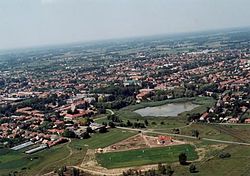Lajosmizse
Lajosmizse | |
|---|---|
 Aerial photography of Lajosmizse | |
|
UTC+2 (CEST) | |
| Postal code | 6050 |
| Area code | (+36) 76 |
| Website | www |
Lajosmizse is a town in
History
Lajosmizse is situated at the meeting point of north-south and east-west routes. Once the area was covered with groves[
The blue in the coat of arms is the colour of transcendence, and signifies that the mediaeval settlement of Mizse already had a stone church, where
The green in the coat of arms recalls the former grovy[
The two combatant lions record that the town once consisted of two settlements. Mizse may have been named after the palatine[
The Jazygian horn, held by the lions, decorated seals as early as the 16th century, serving as the symbol of the Jazygians. It was even related to the well-known legend of the chief Lehel, which is based on two factors. One is that the horn is an artefact from the 9th–10th centuries. The other is that the edge is chipped. This damage may have happened when Lehel struck the German emperor dead. The historical validity of the story is disputed, but its credibility as a legend has remained intact in local tradition. The horn is a symbol of the inhabitants' ethnic coherence, independence and desire for freedom.
The two stars refer to the two main denominations, the Roman Catholics and the
Lajosmizse gained its current name in 1902, and in 1970 the settlement was given back the rank of municipality. In 1993, the President of the Republic of Hungary raised it to the rank of town.
The crest is a memento of the victims and heroes of the past millennium and of the world wars (World War I and World War II), while the crown is the expressive symbol of independence and local autonomy.
The Jewish community in Lajosmizse
Jews settled in the town in the second half of the 19th century.[1] the community was officially organized in 1898 and joined the Orthodox stream. A synagogue was built in the city in 1925. In the summer of 1941, Jewish forced laborers were sent from Laiuszmija to the Ukrainian front, where the Hungarians fought alongside the Germans, some of whom were captured by the Russians. At the end of April 1944, after the entry of the German army into Hungary, Jews were concentrated in Lajosmizse ghetto which was surrounded by several houses. At the end of June, they were transferred with the Jews of the nearby settlements to the ghetto established in a factory in Monor, and a short time later they were sent to the Auschwitz extermination camp.[2]
Twin towns – sister cities
Lajosmizse is twinned with:[3]
 Felsőlajos, Hungary
Felsőlajos, Hungary Jászberény, Hungary
Jászberény, Hungary Palić (Subotica), Serbia
Palić (Subotica), Serbia Remetea, Romania
Remetea, Romania
Gallery
References
- ^ Census of Hungarian Jews
- ^ The Jewish community in Lajosmizse
- ^ "Testvérvárosaink". lajosmizse.hu (in Hungarian). Lajosmizse. Retrieved 10 April 2020.
External links
- Official website in Hungarian





